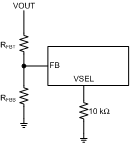JAJSMA0A July 2020 – July 2021 LM63610-Q1
PRODUCTION DATA
- 1 特長
- 2 アプリケーション
- 3 概要
- 4 Revision History
- 5 Device Comparison Table
- 6 Pin Configuration and Functions
- 7 Specifications
- 8 Detailed Description
- 9 Application and Implementation
- 10Power Supply Recommendations
- 11Layout
- 12Device and Documentation Support
- 13Mechanical, Packaging, and Orderable Information
パッケージ・オプション
メカニカル・データ(パッケージ|ピン)
サーマルパッド・メカニカル・データ
発注情報
9.2.2.2 Setting the Output Voltage
The output voltage of the LM63610-Q1 is set by the condition of the VSEL input. This example requires a 5-V output, so the VSEL input is connected to VCC and the FB input is connected directly to the output capacitor.
For cases where the desired output voltage is other than 5 V or 3.3 V, an external feedback divider is required. As shown in Figure 9-2, the divider network is comprised of RFBT and RFBB, and closes the loop between the output voltage and the converter. In this case, a 10-kΩ resistor is connected from the VSEL input go ground. The converter regulates the output voltage by holding the voltage on the FB pin equal to the internal reference voltage, 1 V. The resistance of the divider is a compromise between excessive noise pickup and excessive loading of the output. Smaller values of resistance reduce noise sensitivity, but also reduce the light-load efficiency. The recommended value for RFBT is 100 kΩ with a maximum value of 1 MΩ. If 1 MΩ is selected for RFBT, then a feedforward capacitor must be used across this resistor to provide adequate loop phase margin (see CFF Selection). Once RFBT is selected, Equation 4 is used to select RFBB. VREF is nominally 1 V.

 Figure 9-2 Feedback Divider for Adjustable Output Voltage Setting
Figure 9-2 Feedback Divider for Adjustable Output Voltage Setting